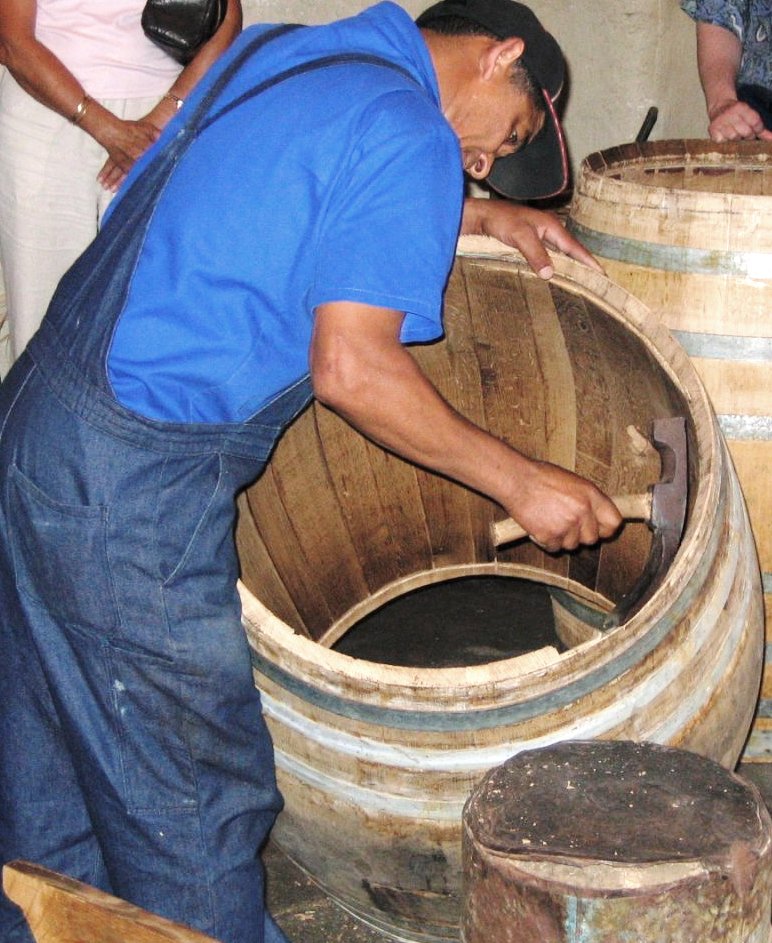|
Blue-collar
A blue-collar worker is a person who performs manual labor or skilled trades. Blue-collar work may involve skilled or unskilled labor. The type of work may involve manufacturing, retail, warehousing, mining, carpentry, electrical work, custodial work, agriculture, logging, landscaping, food processing, waste collection and disposal, construction, shipping, and many other types of physical work. Blue-collar work often involves something being physically built or maintained. In social status, blue-collar workers generally belong to the working class. In contrast, the white-collar worker typically performs work in an office environment and may involve sitting at a computer or desk. A third type of work is a service worker ( pink collar) whose labor is related to customer interaction, entertainment, sales or other service-oriented work — particularly those service jobs that have been traditionally considered to be women's work, such as secretaries, nurses, teachers, early childh ... [...More Info...] [...Related Items...] OR: [Wikipedia] [Google] [Baidu] |
White-collar Worker
A white-collar worker is a person who performs professional service, desk, managerial, or administrative work. White-collar work may be performed in an office or similar setting. White-collar workers include job paths related to government, consulting, academia, accountancy, business and executive management, customer support, design, economics, science, technology, engineering, market research, finance, human resources, operations research, marketing, public relations, real estate, information technology, networking, law, healthcare, architecture, and research and development. In contrast, blue-collar workers perform manual labor or work in skilled trades; pink-collar workers work in care, health care, social work, or teaching; green-collar workers specifically work in the environmental sector; and grey-collar jobs combine manual labor and skilled trades with non-manual or managerial duties. With the emergence of the AI boom, there have been studies released ... [...More Info...] [...Related Items...] OR: [Wikipedia] [Google] [Baidu] |
Pink-collar Worker
A pink-collar worker is someone working in the care-oriented career field or in fields historically considered to be women's work. This may include jobs in the beauty industry, nursing, social work, teaching, secretarial work, or child care. While these jobs may also be filled by men, they have historically been female-dominated (a tendency that continues today, though to a somewhat lesser extent) and may pay significantly less than white-collar or blue-collar jobs. Women's work – notably with the delegation of women to particular fields within the workplace – began to rise in the 1940s, in concurrence with World War II. History William Jack Baumol first used the term pink collar in his 1967 article, "Macroeconomics of Unbalanced Growth: The Anatomy of Urban Crisis." He introduced the term to describe a category of jobs predominantly held by women, often in clerical, administrative, or service-oriented roles. Baumol's focus was not only on the gendered nature of thes ... [...More Info...] [...Related Items...] OR: [Wikipedia] [Google] [Baidu] |
Social Class
A social class or social stratum is a grouping of people into a set of Dominance hierarchy, hierarchical social categories, the most common being the working class and the Bourgeoisie, capitalist class. Membership of a social class can for example be dependent on education, wealth, occupation, income, and belonging to a particular subculture or social network. Class is a subject of analysis for sociologists, political scientists, anthropologists and Social history, social historians. The term has a wide range of sometimes conflicting meanings, and there is no broad consensus on a definition of class. Some people argue that due to social mobility, class boundaries do not exist. In common parlance, the term social class is usually synonymous with Socioeconomic status, socioeconomic class, defined as "people having the same social, economic, cultural, political or educational status", e.g. the working class, "an emerging professional class" etc. However, academics distinguish socia ... [...More Info...] [...Related Items...] OR: [Wikipedia] [Google] [Baidu] |
Working Class
The working class is a subset of employees who are compensated with wage or salary-based contracts, whose exact membership varies from definition to definition. Members of the working class rely primarily upon earnings from wage labour. Most common definitions of "working class" in use in the United States limit its membership to workers who hold blue-collar and pink-collar jobs, or whose income is insufficiently high to place them in the middle class, or both. However, socialists define "working class" to include all workers who fall into the category of requiring income from wage labour to subsist; thus, this definition can include almost all of the working population of industrialized economies. Definitions As with many terms describing social class, ''working class'' is defined and used in different ways. One definition used by many socialists is that the working class includes all those who have nothing to sell but their labour, a group otherwise referred to as the p ... [...More Info...] [...Related Items...] OR: [Wikipedia] [Google] [Baidu] |
Tradesman
A tradesperson or tradesman/tradeswoman is a skilled worker that specialises in a particular trade. Tradespeople (tradesmen/women) usually gain their skills through work experience, on-the-job training, an apprenticeship program or formal education. As opposed to a master craftsman or an artisan, a tradesperson (tradesman/tradeswoman) is not necessarily restricted to manual work. History In Victorian England, The terms "skilled worker," "craftsman," "artisan," and "tradesman" were used in senses that overlap. All describe people with specialized training in the skills needed for a particular kind of work. Some of them produced goods that they sold from their own premises (e.g. bootmakers, saddlers, hatmakers, jewelers, glassblowers); others (e.g. typesetters, bookbinders, wheelwrights) were employed to do one part of the production in a business that required a variety of skilled workers. Still others were factory hands who had become experts in some complex part of th ... [...More Info...] [...Related Items...] OR: [Wikipedia] [Google] [Baidu] |
Carpentry
Carpentry is a skilled trade and a craft in which the primary work performed is the cutting, shaping and installation of building materials during the construction of buildings, Shipbuilding, ships, timber bridges, concrete formwork, etc. Carpenters traditionally worked with natural wood and did rougher work such as framing, but today many other materials are also used and sometimes the finer trades of cabinetmaking and furniture building are considered carpentry. In the United States, 98.5% of carpenters are male, and it was the fourth most male-dominated occupation in the country in 1999. In 2006 in the United States, there were about 1.5 million carpentry positions. Carpenters are usually the first tradesmen on a job and the last to leave. Carpenters normally framed post-and-beam buildings until the end of the 19th century; now this old-fashioned carpentry is called timber framing. Carpenters learn this trade by being employed through an apprenticeship training—normally ... [...More Info...] [...Related Items...] OR: [Wikipedia] [Google] [Baidu] |
Alden, Iowa
Alden is a city in Hardin County, Iowa, Hardin County, Iowa, United States. The population was 763 at the 2020 United States Census, 2020 census. History Alden was laid out in 1855. It was named for its founder, Henry Alden, a native of Massachusetts. The town was incorporated February 11, 1879. Geography According to the United States Census Bureau, the city has a total area of , of which is land and is water. Demographics 2020 census As of the United States census, census of 2020, there were 763 people, 327 households, and 205 families residing in the city. The population density was 495.2 inhabitants per square mile (191.2/km2). There were 356 housing units at an average density of 231.0 per square mile (89.2/km2). The Race and ethnicity in the United States census, racial makeup of the city was 91.9% White Americans, White, 0.1% African Americans, Black or African American, 0.0% Native Americans in the United States, Native American, 0.0% Asian Americans, Asian, 0.3% ... [...More Info...] [...Related Items...] OR: [Wikipedia] [Google] [Baidu] |
Women's Work
Women's work is a field of labour assumed to be solely the realm of women and associated with specific stereotypical jobs considered as uniquely feminine or domestic duties throughout history. It is most commonly used in reference to the unpaid labor typically performed by that of a mother or wife to upkeep the home and children. Women's work is generally unpaid or paid less than "men's work" and is not as highly valued as "men's work". Much of women's work is not included in official statistics on labour, making much of the work that women typically do virtually invisible. For example, throughout much of the 20th century, the women working on a family farm, no matter how much work they did, would be counted in, for example, the US census as being unemployed, whereas the men doing the same or even less work were counted as being employed as farmers. Similarly, many acts of creativity, such as tapestry, quilting, sewing, and weaving, which are often performed by women, have been t ... [...More Info...] [...Related Items...] OR: [Wikipedia] [Google] [Baidu] |
Wage
A wage is payment made by an employer to an employee for work (human activity), work done in a specific period of time. Some examples of wage payments include wiktionary:compensatory, compensatory payments such as ''minimum wage'', ''prevailing wage'', and ''yearly bonuses,'' and wiktionary:remunerative, remunerative payments such as ''prizes'' and ''tip payouts.'' Wages are part of the expenses that are involved in running a business. It is an obligation to the employee regardless of the profitability of the company. Payment by wage contrasts with salary, salaried work, in which the employer pays an arranged amount at steady intervals (such as a week or month) regardless of hours worked, with Commission (remuneration), commission which conditions pay on individual performance, and with compensation based on the performance of the company as a whole. Waged employees may also receive tips or gratuity paid directly by clients and employee benefits which are non-monetary forms of ... [...More Info...] [...Related Items...] OR: [Wikipedia] [Google] [Baidu] |
Mechanic At Work
A mechanic is a Tradesman, skilled tradesperson who uses tools to build, maintain, or Home repair, repair Machine (mechanical), machinery, especially Engine, engines. Formerly, the term meant any member of the handicraft trades, but by the early 20th century, it had come to mean one who works with machinery. Duties Most mechanics specialize in a particular field, such as auto body mechanics, diesel mechanics, air conditioning and refrigeration mechanics, auto mechanics, bicycle mechanics, boiler mechanics, race car mechanics, aircraft mechanics, and other areas. There are also mobile mechanics who work on heavy equipment that will come to you if there is an issue that must be resolved at the location of the machine. A mechanic is typically Certification, certified by a trade association or regional government power. Mechanics may be separated into two classes based on the type of machines they work on, heavyweight and lightweight. Heavyweight work is on larger machines or heav ... [...More Info...] [...Related Items...] OR: [Wikipedia] [Google] [Baidu] |
Slate
Slate is a fine-grained, foliated, homogeneous, metamorphic rock derived from an original shale-type sedimentary rock composed of clay or volcanic ash through low-grade, regional metamorphism. It is the finest-grained foliated metamorphic rock. Foliation may not correspond to the original sedimentary layering, but instead is in planes perpendicular to the direction of metamorphic compression. The foliation in slate, called " slaty cleavage", is caused by strong compression in which fine-grained clay forms flakes to regrow in planes perpendicular to the compression. When expertly "cut" by striking parallel to the foliation with a specialized tool in the quarry, many slates display a property called fissility, forming smooth, flat sheets of stone which have long been used for roofing, floor tiles, and other purposes. Slate is frequently grey in color, especially when seen ''en masse'' covering roofs. However, slate occurs in a variety of colors even from a single locality; for ... [...More Info...] [...Related Items...] OR: [Wikipedia] [Google] [Baidu] |









